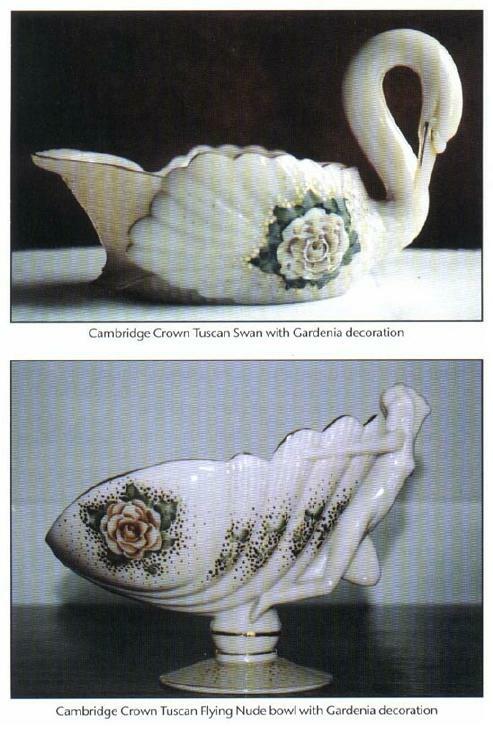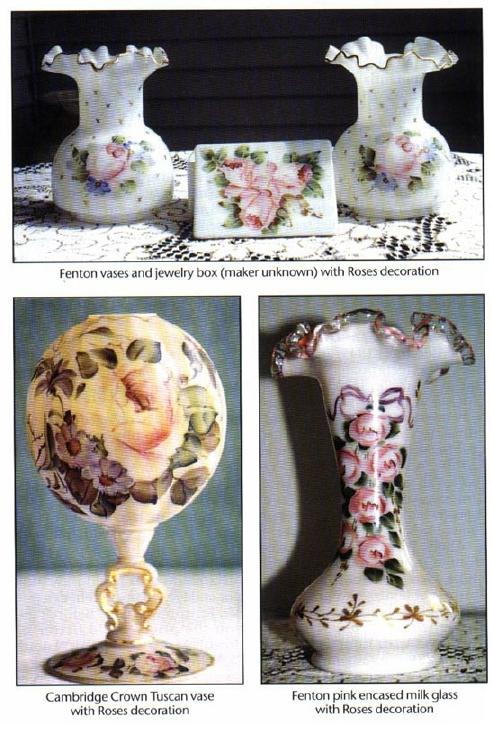National Cambridge Collectors, Inc.
A non-profit 501(c)(3) organization.

The Charleton Decoration, from Abels, Wasserberg & Company
By Helen Klemko
NOTE: This article was originally published in the August-September, 1996 issue of the Glass Collector's Digest. It has been reproduced here by permission of the author.
When springtime arrives each year, we feel refreshed. Mother Nature renews herself, and all the flowers and trees have their vibrant colors.
For those of us who collect items featuring the Charleton design, spring is with us all year. Even in mid-winter, we can see the beautiful roses and gardenias which grace our glassware. Flowers have always been a favorite subject of artists. Whether a floral design is painted on canvas or enameled on porcelain or glass, the beauty remains.
I soon realized that these elegant pieces of glass were not produced by one glassmaker. Abels, Wasserberg & Company purchased "blanks" from various glass factories, then decorated the pieces with designs of flowers, fruit, or landscapes. These designs were registered under the Charleton trademark. Although Abels, Wasserberg sold other lines as well, the many and varied designs under the Charleton name were their most successful products.
Regardless of the origin of the glass, the decorations are eye-catching. I'm in awe of the craftsmen's ability to depict flowers with such lifelike intensity. Although I prefer certain glassmakers, I find that the decorations allow me to look beyond and truly appreciate the artisan who has added the personal touch. On a number of my "finds" there is a Charleton label still attached which shows a handwritten number. I assume this number identifies the decorator who took personal pride in his or her work.
Abels, Wasserberg, & Company was in business more than 40 years. With its headquarters at 63 Green Street in New York City, and additional show rooms in Chicago and Los Angeles, the firm continued into the 1970s.
Prior to the Second World War, about one-third of the china and glass sold in the United States was of foreign origin. During the war, however, these imports became unavailable, and domestic glassmakers had to increase production to fill the void.
In 1943, Walter J. Abels, company president, was quoted in China and Glass that his firm "quickly adapted to the products of domestic china and glass factories and developed a decorating shop which is today capable of producing commercial hand decorations which are at least the equal of any foreign product." With the drain on labor and supplies for the war effort, this was a very difficult task.
Abels, Wasserberg & Company was extremely diversified in its production. In December 1943, they advised a potential distributor that they had more than 375 styles of table and boudoir lamps, an assortment suitable for every type of interior decoration. In addition, a large line of gift accessories was available: "All are beautifully decorated by hand and are equal to the finest pieces that used to be obtained in Europe. Included are toilet sets, bottles, powder boxes, trays, desk sets, cache pots, flower pots, figurines, book ends, bathroom sets, decorative plates and plaques, ash trays, cigarette boxes, candy boxes, nut trays, and many other items."
An article in The Gift and Art Buyer (December 1945) advises that Abel, Wasserberg occupied a 10,000 square foot facility in New York, employing 55 persons solely engaged in hand decorating. Many of these artisans, (both men and women) had acquired their expertise at famous European establishments. Even those with considerable experience, however, were given 18 months of supervised training before they were allowed to be "Charleton" artists.
Abels, Wasserberg purchased "blanks" from Fenton, Duncan and Miller, Westmoreland, Cambridge, Fostoria, Aladdin, and other well-known glass manufacturers. The article from Gift and Art Buyer explains, "Apart from the decoration, there is the designing, styling, and actual making of the glass and china pieces. The delicate textures and fine glazes for which this ware is equally well known are accomplished only after the solution of an entirely different set of problems. One illustration of the complications which occur is that 25 factories supply different types of glass and that each type requires a different temperature for firing."
At this time, there were 4,000 Charleton distributors in the United Stated. The article states that the firm also anticipated considerable business with South and Central American, Cuba, and the Near East.
As the 1940s drew to a close, there was great concern about the future of glass manufacturing the United States. Foreign competition had the advantage of cheaper labor and, in some cases, benefited from government subsidies. These concerns were justified, since foreign competition was a key factor in the closing of American glass plants in the 1950s and '60s.
Abels, Wasserberg & Company continued to buy and decorate American glass during the post-war decades. Frank M. Fenton, retired CEO of the Fenton Art Glass Company, remembers making a sales call on Walter Abels in the 1950s. Mr. Fenton had brought with him a 10" Hobnail Cranberry Opalescent lampshade - an expensive cased piece made with a gold-ruby interior and French opalescent exterior. Mr. Fenton warned, "Before I tell you the price, you'd better sit down!" Mr. Abels replied, "I don't care how high the price is, as long as it's a good seller!" Mr. Fenton recalls that Abels, Wasserberg and Company was well respected throughout the glass industry. In 1967, Walter Abels summed up his company's philosophy when he said, "We are proud of our ability to make and distribute beautiful functional articles that bring light and happiness to the human dwelling places of the world."
Although a large quantity was produced, it's difficult to find Charleton-decorated pieces at today's antique shows and auctions. One could surmise that the beauty of these pieces encompasses all ages, and that the lamps, vases, and other items are passed down from one generation to another.
(Webmaster's NOTE: Since this article was published, Michael & Lori Palmer have released a book on Charleton which contains a host of information on the Abels, Wasserberg & Company products.)
Photos below were also printed in the issue. Scanner shows yellow lines for some strange reason!
 |
 |